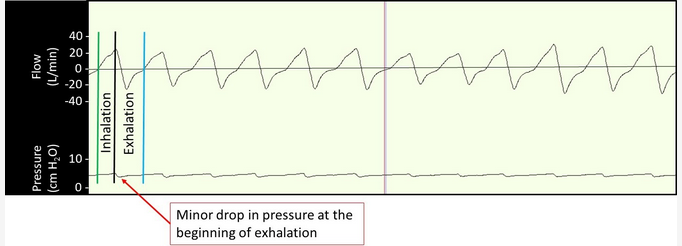CPAP with expiratory pressure relief
- related: Sleep and Sleep Disordered Breathing
- tags: #literature #pulmonology
 The pressure and flow curves demonstrate that the patient is on a positive pressure of 5 cm H2O and that at the beginning of each exhalation phase, the pressure is decreased by approximately 1 to 2 cm H2O, consistent with CPAP with expiratory pressure relief (choice B is correct). As illustrated in Figure 2, expiratory pressure relief is a comfort feature available in home CPAP devices and is designed to decrease the CPAP pressure by 1 to 3 cm H2O during the early phase of exhalation (arrow), but the pressure gradually increases to baseline. The flow curve shows no evidence of inspiratory flow limitation (time between the green and the black vertical lines is inspiratory time) or expiratory flow limitation (time between the black and the blue vertical lines is expiratory time), suggesting resolution of obstructive upper airway events while on CPAP.
The pressure and flow curves demonstrate that the patient is on a positive pressure of 5 cm H2O and that at the beginning of each exhalation phase, the pressure is decreased by approximately 1 to 2 cm H2O, consistent with CPAP with expiratory pressure relief (choice B is correct). As illustrated in Figure 2, expiratory pressure relief is a comfort feature available in home CPAP devices and is designed to decrease the CPAP pressure by 1 to 3 cm H2O during the early phase of exhalation (arrow), but the pressure gradually increases to baseline. The flow curve shows no evidence of inspiratory flow limitation (time between the green and the black vertical lines is inspiratory time) or expiratory flow limitation (time between the black and the blue vertical lines is expiratory time), suggesting resolution of obstructive upper airway events while on CPAP.
Bilevel positive airway pressure (PAP) therapy is present when there is a minimum of 4 cm H2O difference between the inspiratory PAP (IPAP) settings and expiratory PAP (EPAP) settings (ie, pressure support) (choices A and C are incorrect). The difference between IPAP and EPAP of 4 cm H2O in order to establish bilevel PAP is an arbitrary threshold set by the US Food and Drug Administration years ago in order to distinguish CPAP from bilevel PAP. Volume targeted pressure support is a mode of bilevel PAP noninvasive ventilation in which the inspiratory pressure (IPAP) is not fixed as in bilevel PAP, but rather it can fluctuate in order to target a preset tidal volume (choice D is incorrect).1
- EPR 3 cm is more comfortable drop
- Use EPR all the time with 20 min ramp